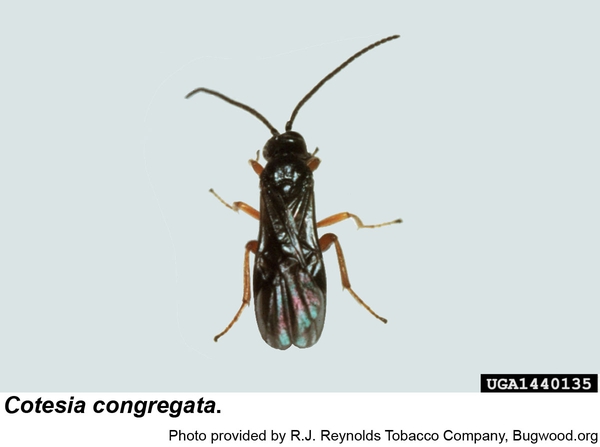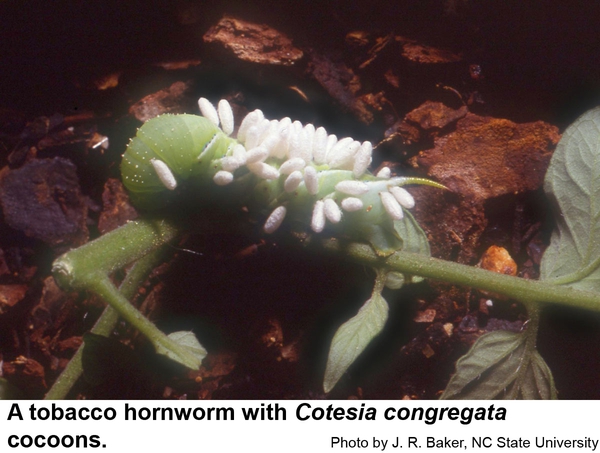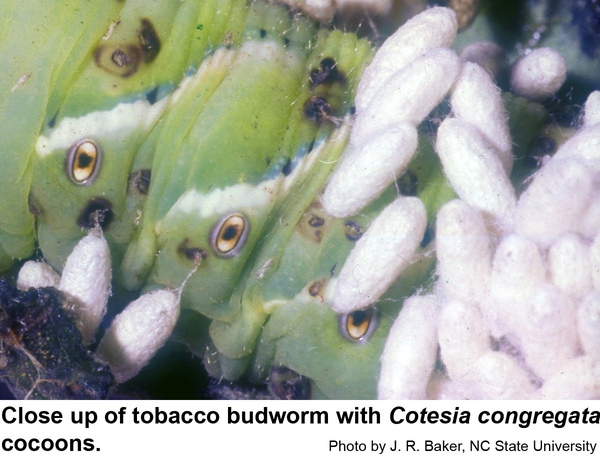Description and Biology
Cotesia congregata parasitoids are small (up to 1/8 inch long), black wasps with slender, black antennae about as long as the body. The wings have a dark spot but are otherwise clear and colorless or dark, smokey gray. Cotesia congregata eggs are wedge-shaped but extremely small and injected inside the host. Likewise the various stages of the pale, grub-like larvae are only found inside the caterpillar except for when the second stage larvae (almost 3/16 inch long) chew through the integument, molt, and spin their cocoons. Pupae are about the size of adults, but have the legs, antennae, and wing pads closely wrapped around the body. Pupae darken as they mature. This parasitoid can be found on flowers where they sip nectar. Female Cotesia congregata parasitoids are attracted to the smell of caterpillar-damaged plants that they actively search. When a suitable caterpillar is encountered, she punctures its skin and lays a few to 300+ eggs into its hemolymph (blood). Venom she also injects paralyzes the poor caterpillar, and virus particles that are introduced prevent an immune reaction to the eggs. Tiny wasp larvae hatch and develop in the hemolymph. Second stage larvae eventually emerge, molt, and spin white cocoons attached to the caterpillar's skin more or less all at the same time. Some 3 to 8 days later, after molting into a pupa and molting again into an adult inside the cocoon, an adult wasp emerges to mate and find new hosts. Larvae spinning cocoons in the late growing season overwinter inside the cocoon and pupate the following spring. These cocoons sometimes fall from the caterpillar and the larvae survive on the soil surface. Development from egg to chewing out of the caterpillar usually takes about 2 weeks (5 to 16 days). Cotesia congregata is but one of about 400 species in the genus Cotesia. All are parasitoids, but Cotesia congregata is unique because its snow white cocoons adhere to the host caterpillar's skin as the poor thing clings to its host plant— alive, but virtually paralyzed.
Hosts
Cotesia congregata infests a number of hornworms including tobacco hornworms and tomato hornworms. Some owlet moth caterpillars are also susceptible but are usually not preferred hosts.
Residential Recommendations
Cotesia congregata cocoons are small, but conspicuous, and they often call attention an hitherto unnoticed host hornworm. Amateur horticulturists sometimes mistake the cocoons as eggs that the hornworm has laid and so destroy this beneficial biological control. It is best to leave the parasitized caterpillar in place so that the wasps can safely emerge to carry out their biological control “duties.”
Other Resources
- Common name: a parasitoid wasp, scientific name: Cotesia congregata (Say) (Insecta: Hymenoptera: Braconidae).Crockett, C. D. et al. 2014. Featured Creatures, Entomology & Nematology, FDACS/DPI, EDIS. Pub. EENY-598.
- Cotesia congregata (sic). Hupman, K. 2015 (last modified). BugwoodWiki.
- Cotesia Congregata (sic), Vol. 6, No. 25 . Layton, B. 2020. Bug's Eye View. Mississippi State University Extension.
- Cotesia Wasp. Orr, D. 2020. Entomology—Insect Biology and Management.
- NC State Extension Plant Pathology Publications
- NC State Horticultural Science Publications
- North Carolina Agricultural Chemicals Manual
For assistance with a specific problem, contact your local N.C. Cooperative Extension center.
This factsheet has not been peer reviewed.
Publication date: May 26, 2021
N.C. Cooperative Extension prohibits discrimination and harassment regardless of age, color, disability, family and marital status, gender identity, national origin, political beliefs, race, religion, sex (including pregnancy), sexual orientation and veteran status.



